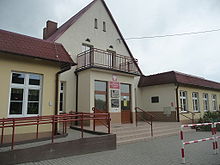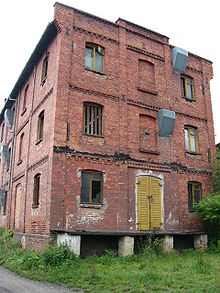Pobiel
| Pobiel | ||
|---|---|---|
 Help on coat of arms |
|
|
| Basic data | ||
| State : | Poland | |
| Voivodeship : | Lower Silesia | |
| Powiat : | Góra | |
| Geographic location : | 51 ° 34 ′ N , 16 ° 45 ′ E | |
| Residents : | ||
Pobiel (German Pobil , also Bobile ; 1936–1945: Wandelheim ) is a village of Gmina Wąsosz in the powiat Górowski in the Lower Silesian Voivodeship in Poland .
geography
The predominantly agricultural village has numerous vacant houses and, in some cases, dilapidated farms. Modern measures of village design are the construction of a village square and the construction of a small church and a school building. The Orla , a tributary to the Barycz (Bartsch), flows directly past the place.
history
1319 the place in connection with the acquisition of the Pobielu Castle by Bolesław III. first mentioned. Another document dates from 1329 and deals with sovereignty over the principality. In the 2nd half of the eighteenth century a school, 4 water mills, 2 windmills and 2 communal houses are recorded. With Zubrzą, the village was part of the royal domain in Wąsoszu. In 1845 the place had 829 inhabitants.
Refugee Trek 1945
The mayor of Wandelheim decided in 1945 to evacuate the village due to the approaching Red Army . A refugee trek with horse and cart pulled on January 20, 1945 with the German-born population in the west. Only a few elderly people stayed behind. The place was later repopulated by Polish people. The route of the trek ran u. a. via Żagań , Riesa , Freiberg , Chemnitz , Plauen , Hof to Kirchenthumbach , where the trek should be divided. When some of them met the Americans in Gaißach via Velden on Good Friday (March 30) , the onward journey was also left to the individual cars. In the hope of returning home, the majority of the cars made their way back north, but were mostly turned away at the zone border between the American and Soviet occupation zones . Others were no longer admitted to Poland on the Oder-Neisse border . Many of the refugees initially settled in the Hof district .
Attractions
- Old watermill, No. 51
- Cemetery from the 2nd half of the 19th century


